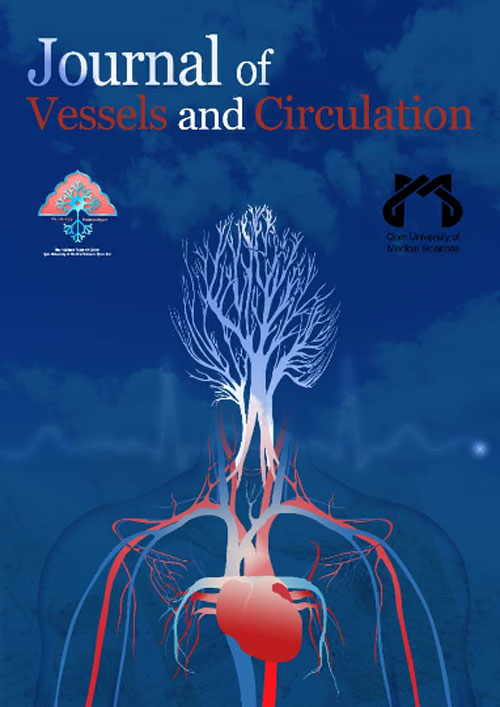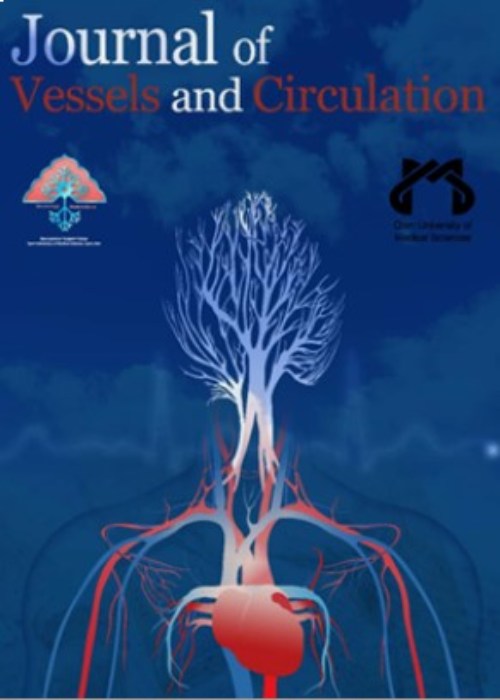فهرست مطالب

Journal of Vessels and Circulation
Volume:2 Issue: 4, Autumn 2021
- تاریخ انتشار: 1401/06/21
- تعداد عناوین: 8
-
-
Pages 151-160Introduction
Children with heart defects who need angiography are increasing. They have high anxiety and stress. Implementing an effective program for children undergoing angiography is one of the tasks of nurses. This article has been compiled with the aim of reviewing nursing interventions for children under angiography.
MethodElsevier, SID, Magiran, Scopus, PubMed, and Google Scholar databases were searched using keywords such as coronary angiography, nonpharmacological interventions, nursing interventions, pediatric, infant, children, and complementary therapies during 1984–2021. From 60 studies in the initial search, 12 studies were maintained.
FindingsThere are several solutions that can reduce stress in children under angiography: including music therapy, play therapy including digital games, distraction, and relaxation therapy.
ConclusionPediatric nursing interventions under angiography can play an effective role in the recovery process. Children undergoing angiography have interventions to reduce stress according to their developmental age. Depending on the environmental and psychological and social conditions of the child, solutions can be adopted and implemented so that children and their parents experience less stress.
Keywords: Angiography, pediatrics, nursing care, intervention, stress -
Pages 161-169Background and Aim
Coronary patients with type d personality have high stress and because they inhibit negative emotions, despite receiving similar medical procedures as other coronary patients, show a slower recovery process and recurrent heart attacks. they give. The aim of this study was to compare the effectiveness of compassion-based therapy and stress-based mindfulness in reducing type D personality symptoms in patients with coronary heart disease.
MethodsThe present research method was quasi-experimental with pre-test-post-test-follow-up design with a control group. The statistical population of this study was all patients with coronary heart disease in Rajaei Alborz Hospital in Karaj in 1398, from which 45 people were selected by available sampling method and randomly assigned to three treatment groups based on compassion and mindfulness. Based on stress reduction and the control group. Subjects responded to the Denvelt (2005) personality type scale for pretest, posttest, and follow-up. Compassion-based therapy and stress-based mindfulness therapy were each performed in 8 sessions of 90 minutes each. In the present study, the statistical method of analysis of variance with repeated measures design, SPSS software and significance levels of 0.05 and 0.01 were used to analyze the data.
ResultsThe results showed that compassion-based therapy and stress-based mindfulness therapy had a reducing effect on type D personality symptoms (P <0.001). Compassion-based therapy and stress-based mindfulness therapy had a reducing effect on type D personality symptoms over time (P <0.001). There was a significant difference between the effectiveness of compassion-based therapy and stress-based mindfulness treatment in reducing type D personality symptoms (P = 0.020).
ConclusionCompassion-based therapy and stress-based mindfulness are both effective in treating patients with type d personality, but compassion-based therapy is more effective.
Keywords: Type D, Mindfulness, Compassion, Coronary arteries -
Pages 171-178Introduction & Objective
Corona virus, by targeting cellular antigens, causes severe infection and disease. The aim of this study was to evaluate the frequency of ABO blood types in patients with Covid-19.
Materials and MethodsIn this descriptive study, 343 patients with Covid-19 admitted to Ali Ibn Abitaleb (AS) Hospital in Rafsanjan in the first half of 1399 were included in the study by available means. The study checklist including demographic characteristics, along with blood type, HRCT-based pulmonary involvement and disease severity based on clinical signs was completed. Data were analyzed using chi-square and logistic regression tests. The significance level of the tests was considered 0.05.
ResultsOut of 343 subjects, 108 (31.5%) were blood type B, 102 (29.7%) were blood type O, 98 (28.6%) were blood type A and 35 (10.2%) ) Had blood type AB. The results of regression analysis showed that the severity of the disease was 31.9% higher in people with blood type O than in people with blood type A. Also, the rate of pulmonary involvement in people with blood group B was 16% and people with blood group AB was 20.6% and people with blood group O were 39.8% lower than blood group A.
ConclusionThe chance of disease severity was lower in blood group B and higher in blood group O than blood group A, although this chance was not significant. Also, the severity of pulmonary involvement was lower in blood group O and higher in blood group AB than blood group A, which was not significant.
Keywords: Covid-19, blood group, disease severity, pulmonary involvement -
Pages 179-186Background and Aim
Anabolic steroids cause damage to various tissues, including the heart. This study aimed to evaluate the effect of aerobic exercise on Malondialdehyde (MDA) and superoxide dismutase (SOD) of heart tissues in rats poisoned with the anabolic steroid Dianabol.
Materials and MethodsIn this experimental-fundamental study, 18 rats were selected and divided into three 6-series groups, including normal saline intake (Sh), Dianabol (D), and steroid intake with aerobic exercises (D+RT). For six weeks, the steroid and aerobic exercise groups received 5 mg/kg of Dianabol per day peritoneally, and the steroid aerobic exercise group performed aerobic exercise five sessions per week. Measurement of MDA and SOD gene expression in heart tissue was measured by ELISA. Kolmogorov-Smirnov statistical tests, a 1-way analysis of variance with Tukey post hoc test were used to analyze the results (P≤0.05).
ResultsSteroid Dianabol had a significant effect on increasing MDA (P=0.001) and decreasing SOD (P=0.001) in heart tissue. However, aerobic exercise decreased MDA (P=0.001) and increased the SOD antioxidant index (P=0.000) in the heart tissue of rats exposed to Dianabol.
ConclusionAnabolic steroids appear to increase oxidative stress indices and decrease antioxidants in heart tissue, while aerobic exercise can improve elevated levels of oxidative stress and decreased levels of antioxidants.
Keywords: Exercise, Malondialdehyde, Superoxide dismutase, Anabolic steroids, Testosterone congeners -
Pages 187-194Background and Aim
Stroke, mainly caused by atherosclerosis, is the second leading cause of death worldwide. Atherosclerosis may be caused by spleen dysfunction, and oxidative stress intensifies the brain damage induced by cerebral ischemia. According to the studies, cinnamon and lentils as hot and cold temperaments, respectively, contain antioxidant compounds and affect spleen function. This study investigated and compared the effect of cinnamon and lentils in preventing stroke.
Materials and MethodsCinnamon and lentil extracts were injected intraperitoneally daily to adult male Wistar rats for 30 days, and at the end, a rotarod test was carried out. Then, blood samples were taken from their eyes. The rats were submitted to the ischemic stroke, and the activity level of Catalase (CAT), Superoxide Dismutase (SOD), and total antioxidant were measured. The ischemic stroke model was implemented using the MCAO method. Infarct area and ischemic tolerance were measured by the MCAO (Middle Cerebral Artery Occlusion) method, and infarct volume was assessed by 2,3,5-triphenyl tetrazolium chloride.
ResultsChronic use of lentil extract decreased motor function, CAT, SOD, and total antioxidant activity compared with cinnamon extract. The cinnamon extract improved the ischemic tolerance and reduced the infarct size. The group receiving lentil extract could not tolerate ischemia and died during the experiment.
ConclusionIt seems that diet adjustment can effectively reduce the incidence of stroke or its complications. Awareness of food temperament and its relationship with various diseases can reduce disease burden, though further studies should be conducted on this topic.
Keywords: Lentil, Cinnamomum zeylanicum, Acute stroke, Anti-oxidants -
Pages 195-200Background and Aims
Hemorrhagic shock (HS) is one of the most important causes of death. In this study, was investigated the benefits of therapeutic hypothermia (32 °C) during HS on blood pressure (B.P), and the role of thyroid hormones during HS.
Material and MethodsTwenty-four male Wistar rats were divided into two groups of normothermic (NH) and hypothermic (HH) (32 °C during shock); the animals were then anesthetized, and a microcatheter was inserted into the femoral artery and one into femoral vein. The arterial sampels centrifuged, and plasma were isolated to measure thyroid hormones later. The microcatheter was fixed to a physiograph to record B.P. Animals were involved to HS for 90 minutes by withdrawing blood from the femoral vein. B.P was assessted during HS.
ResultsThe amount of B.P of hypothermic animals was significantly higher in most times of HS and at 40 minutes (56.8 ± 4.2 mmHg) than in normothermic rats (45.4 ± 3.8 mmHg) (p <0.05). In addition, the amount of B.P in hypothermic animals at the end of the shock period at 90 minutes (63.8 ± 5.5 mmHg) was significantly (P <0.001) higher in comparisoin with the normotormic groups (39 ± 3.2 mmHg). Levels of thyroid hormones T4 and T3 at the end of shock were lower in the hypothermic group than in the normothermic group (p <0.001).
ConclusionTherapeutic hypothermia indirectly by reducing the level of thyroid hormones and directly reduces the metabolism of non-vital tissues, and preseves blood in the central arteries and increases B.P.
Keywords: Hemorrhagic shock, Therapeutic hypothermia, Thyroid hormones, Rat -
Pages 201-208Background and Objectives
Exercise is a powerful physiological stimulus that can directly or indirectly affect the process of cardiac apoptosis by affecting a number of extracellular and intracellular signaling pathways. The aim of this study was to investigate the effect of aerobic exercise on cardiac tissue apoptosis in rats poisoned with oxygenated water.
MethodsIn this experimental study, 24 male Wistar rats with weight range (220-200 g) and mean age (8-10) weeks were divided into 3 groups of 8: 1) HC healthy control, 2) TC poisoning control, and 3) AE poisoned aerobic exercise. To induce apoptosis, 9% oxidant, which has a large amount of oxygenated water, was used by inhalation for 3 hours daily. 24 hours after the last exercise, rats were sacrificed and their tissue samples were isolated and kept at -80 ° C. Then, the expression of BAX, caspase 3 and BCL2 genes in cardiac tissue was measured using R T-PCR. Kalmogorov-Smirnov statistical test, one-way analysis of variance with Tukey post hoc test in SPSS software version 22 were used to analyze the findings (p≥0.05).
ResultsExposure to oxygenated water significantly increased BAX (P = 0.001) and caspase 3 (P = 0.002) and significantly decreased BCL2 gene expression (P = 0.001) in cardiac tissue. While aerobic exercise decreased BAX levels (P = 0.001) and caspase 3 (P = 0.001) and increase in BCL2 (P = 0.000) were oxygenated in the heart tissue of rats poisoned with water.
ConclusionIt seems that a course of aerobic exercise with significant changes in the expression of genes involved in oxygenated apoptosis can be used as a complementary therapy, along with other methods, to modulate cardiac tissue apoptosis.
Keywords: Aerobic exercise, apoptosis, heart tissue, hydrogen peroxide -
Pages 209-215Background and Objectives
Exercise improves the function of mitochondrial proteins and enzymes in aging. The aim of this study was to investigate the effect of a HIIT training session on the expression of PGC-1α, SIRT1 and SIRT3 genes in the heart tissue of elderly female rats.
MethodsIn this experimental study, 14 female Sprague Dovali rats with a mean age of 16-18 months and a weight range of 320-280 g were randomly divided into 2 groups of 7 including control group (C) and HIIT training group (TH). . The experimental group performed HIIT exercises for 8 weeks and 5 days a week with an intensity of 110% -85% VO2max. Forty-eight hours after the last training session, the rats were anesthetized by intraperitoneal injection of ketamine and vylazine, and the target tissue was immediately removed for examination. Shapiro-Wilk statistical test and one-way analysis of variance were used to analyze the findings in SPSS software version 22 (p ≥ 0.05).
ResultsThe results of the present study showed that the expression of PGC-1α, SIRT1 and SIRT3 genes increased after 8 weeks of HIIT training in the heart tissue of the experimental group compared to the control group, but this increase was not significant (P ≥0.05).
ConclusionIt seems that in elderly conditions, exercising from pathways other than PGC-1α improves mitochondrial function. However, further research is needed on the effect of HIIT exercise on the expression of these genes in heart tissue.
Keywords: HIIT Training, Mitochondrial Biogenesis, Elderly, Heart


